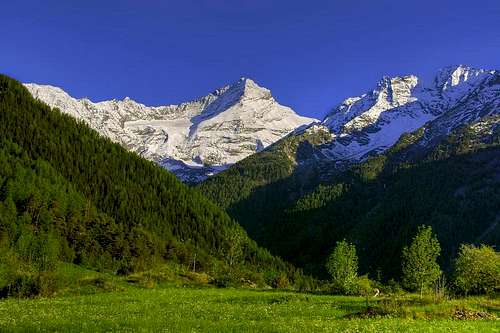|
|
Mountain/Rock |
|---|---|
|
|
45.59656°N / 7.25686°E |
|
|
13022 ft / 3969 m |
|
|
Overview
Getting There
Leave the Highway at "Aosta Ovest" (West), drive through Aymavilles and continue to follow the main street until you arrive in Cogne.HOW TO REACH AOSTA:
- from Italy: Milan - Novara - Ivrea - Pont-Saint-Martin - Saint Vincent - Aosta
or: Turin - Ivrea - Aosta
- from Switzerland: Bern - Montreux - Martigny - Colle del Gran San Bernardo - Aosta
or: Sion - Martigny - Col du Grand Saint Bernard - Aosta
or: Bellinzona - Lugano - Como - Milano (only direction) - Novara - Aosta
- from France (also Genève): Tunnel del Monte Bianco (toll) - Courmayeur - Aosta
or (less expensive but a little longer, if you come from Genève take the tunnel!): Colle del Piccolo San Bernardo - La Thuile - Pre-Saint-Didier - Aosta
- from Austria: Brennero - Trento - Verona (only direction) - Brescia - Bergamo - Milan - Aosta
HOW TO REACH THE SUMMIT:
Normal route (PD+) :
From Cogne hike up the Val Lauson until you reach after approximately 3 hours the Rifugio Vittorio Sella (2585 m, guarded June-September). Continue following the trail heading in direction of Col Lauson until the junction at point 2844 m. Turn rigth (north) and climb Col de la Rousse (3195 m). Proceed climbing towards west and reach the Col de la Noire (3491 m) from where la Grivola finally appears. Cross the Trajoz glacier towards the bottom of the south-east flank. Start climbing in the middle of the wall. When you are half way up, cross right and then continue climbing. Afterwards cross right again and reach the north-east ridge. No head towards the summit. (6-7 hours from Rifugio Sella)
Red Tape
No permits required. No fees or seasonal closures although the huts are not guarded from October to May. Wild camping is prohibited.When To Climb
From mid-June until september. Beware, snow is always possible.Camping
Wild camping in the Parco Nazionale del Gran Paradiso is strictly forbidden!On cogne.org you will find all informations about camping sites and hotels in the area.
Just for example:
Camping lo Stambecco
Hotel Bellevue
Hotel Sant'Orso and Hotel Grand Paradis
Huts and bivouacs:
Rifugio Vittorio Sella (2584 m):
Conca di Lauson (Cogne)
Tel.: 0039/0165/74310
eMail: info@rifugiosella.com
Rifugio Federico Chabod (2750 m):
Côte Savolère di Montandayné (Valsavarenche)
Tel.: 0039/0165/95574
eMail: info@rifugiochabod.com
Rifugio Vittorio Emanuele II (2732 m):
Moncorvè (Valsavarenche)
Tel.: 0039/0165/95920
eMail: segreteria@caitorino.it
Bivacco Mario Gontier (2309 m)
Alpe Gran Nomenon
Bivacco Mario Balzola (3477 m)
Col des Clochettes
Bivacco Luciano Gratton (3198 m)
Col Pousset
Mountain Conditions
Esprit Montagneweather conditions: Bollettino meteorologico VdA
weather conditions: meteo.it
Parco Nazionale del Gran Paradiso


















